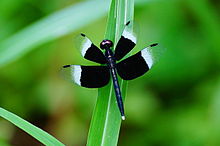Neurothemis tullia
| Pied paddy skimmer | |
|---|---|
 | |
| Male | |
 | |
| Female | |
Conservation status | |
| Scientific classification | |
| Domain: | Eukaryota |
| Kingdom: | Animalia |
| Phylum: | Arthropoda |
| Class: | Insecta |
| Order: | Odonata |
| Infraorder: | Anisoptera |
| Family: | Libellulidae |
| Genus: | Neurothemis |
| Species: | N. tullia |
| Binomial name | |
| Neurothemis tullia (Drury, 1773) | |
| Synonyms | |
| |
Neurothemis tullia,[2] the pied paddy skimmer,[3][4] is a species of dragonfly found in south and south-east Asia. It appears in Bangladesh, China, Hong Kong, India, Malaysia (Peninsular Malaysia), Myanmar, Nepal, Sri Lanka, Taiwan, Thailand, Cambodia and Viet Nam.[1][5]
Description and habitat
It is a black dragonfly with a pale yellow mid-dorsal carina of thorax. Wings are hyaline for apical half and opaque steely blue-black for basal half which is bordered by a milky white patch towards the tip. Females differ remarkably from the males both in body-colouring and markings and in marking of the wings. Its body is greenish yellow with a bright yellow mid-dorsal carina of thorax. Base of wings are amber yellow followed by a blackish brown patch. Apices of all wings are broadly opaque blackish brown and the remaining halves are pale yellow.[6][7][8][3][4]
It breeds in marshes, well vegetated ponds, lakes and rice fields. It perches very close to ground and its flight is very weak.[6][8]
-
 Young male
Young male - Male
-
 male
male -
 female
female -
 Mating pair
Mating pair
See also
References
- ^ a b Dow, R.A. (2009). "Neurothemis tullia". IUCN Red List of Threatened Species. 2009: e.T163754A5646477. doi:10.2305/IUCN.UK.2009-2.RLTS.T163754A5646477.en. Retrieved 20 November 2021.
- ^ Paulson, D.; Schorr, M.; Abbott, J.; Bota-Sierra, C.; Deliry, C.; Dijkstra, K.-D.; Lozano, F. (2023). "World Odonata List". OdonataCentral, University of Alabama. Retrieved 14 March 2023.
- ^ a b "Neurothemis tullia Drury, 1773". India Biodiversity Portal. Retrieved 18 March 2017.
- ^ a b "Neurothemis tullia Drury, 1773". Odonata of India, v. 1.00. Indian Foundation for Butterflies. Retrieved 18 March 2017.
- ^ K.A., Subramanian; K.G., Emiliyamma; R., Babu; C., Radhakrishnan; S.S., Talmale (2018). Atlas of Odonata (Insecta) of the Western Ghats, India. Zoological Survey of India. pp. 344–345. ISBN 9788181714954.
- ^ a b C FC Lt. Fraser (1936). The Fauna of British India, including Ceylon and Burma, Odonata Vol. III. Red Lion Court, Fleet Street, London: Taylor and Francis. pp. 360-362.
- ^ C FC Lt. Fraser (1924). A Survey of the Odonate (Dragonfly) Fauna of Western India and Descriptions of Thirty New Species (PDF). p. 437.
- ^ a b Subramanian, K. A. (2005). Dragonflies and Damselflies of Peninsular India – A Field Guide.
External links
- Pied Parasol (Neurothemis tullia tullia) – Kalahe, Galle, Sri Lanka
- Md Rawi, Che Salmah (1996) Some Aspects of the Biology and Ecology of Neurothemis Tullia (Drury) (Odonata:Libellulidae) in the Laboratory and Rainfed Rice Field in Peninsular Malaysia. PhD thesis, Universiti Putra Malaysia.
 Data related to Neurothemis tullia at Wikispecies
Data related to Neurothemis tullia at Wikispecies
 Media related to Neurothemis tullia at Wikimedia Commons
Media related to Neurothemis tullia at Wikimedia Commons
- v
- t
- e


















